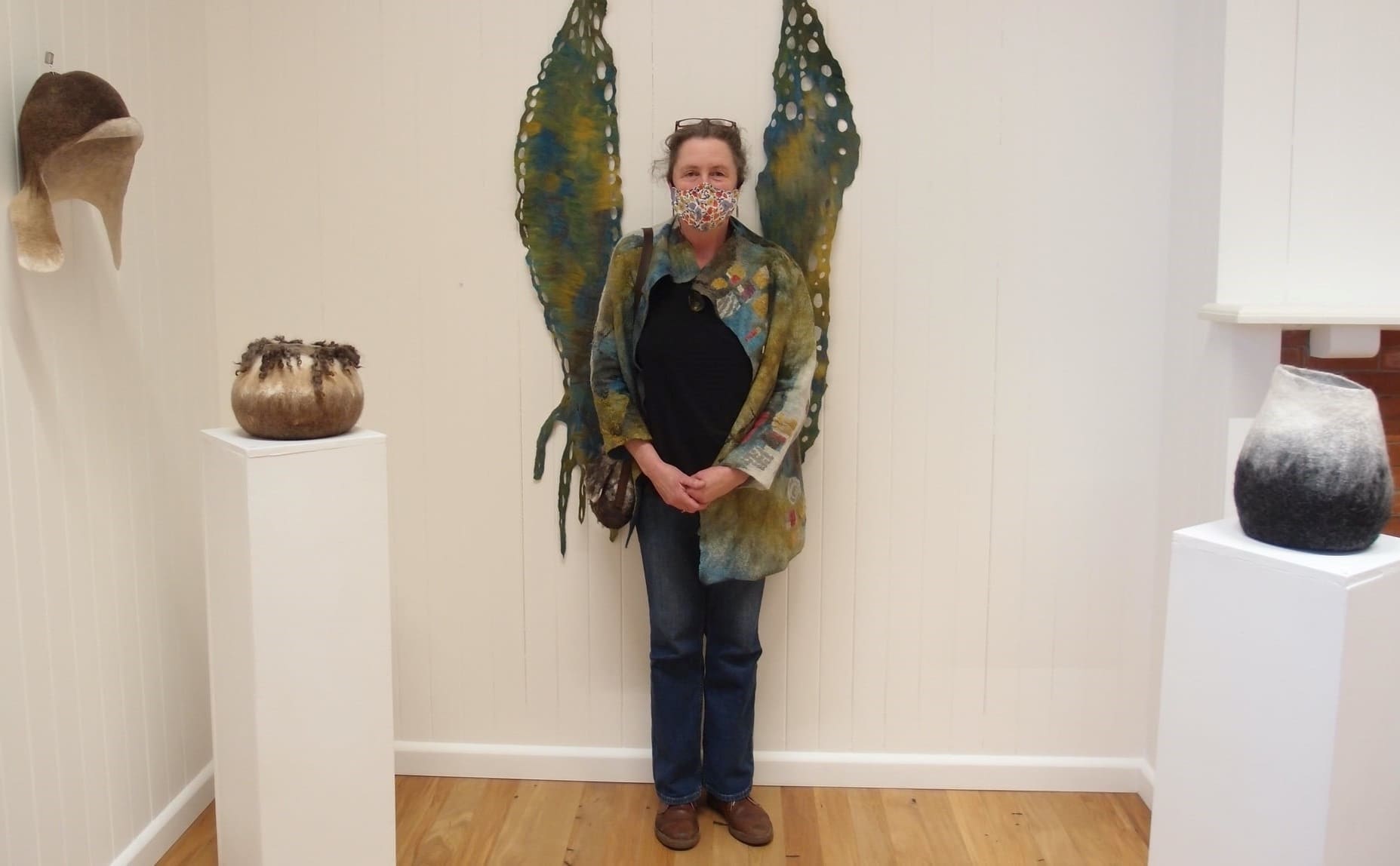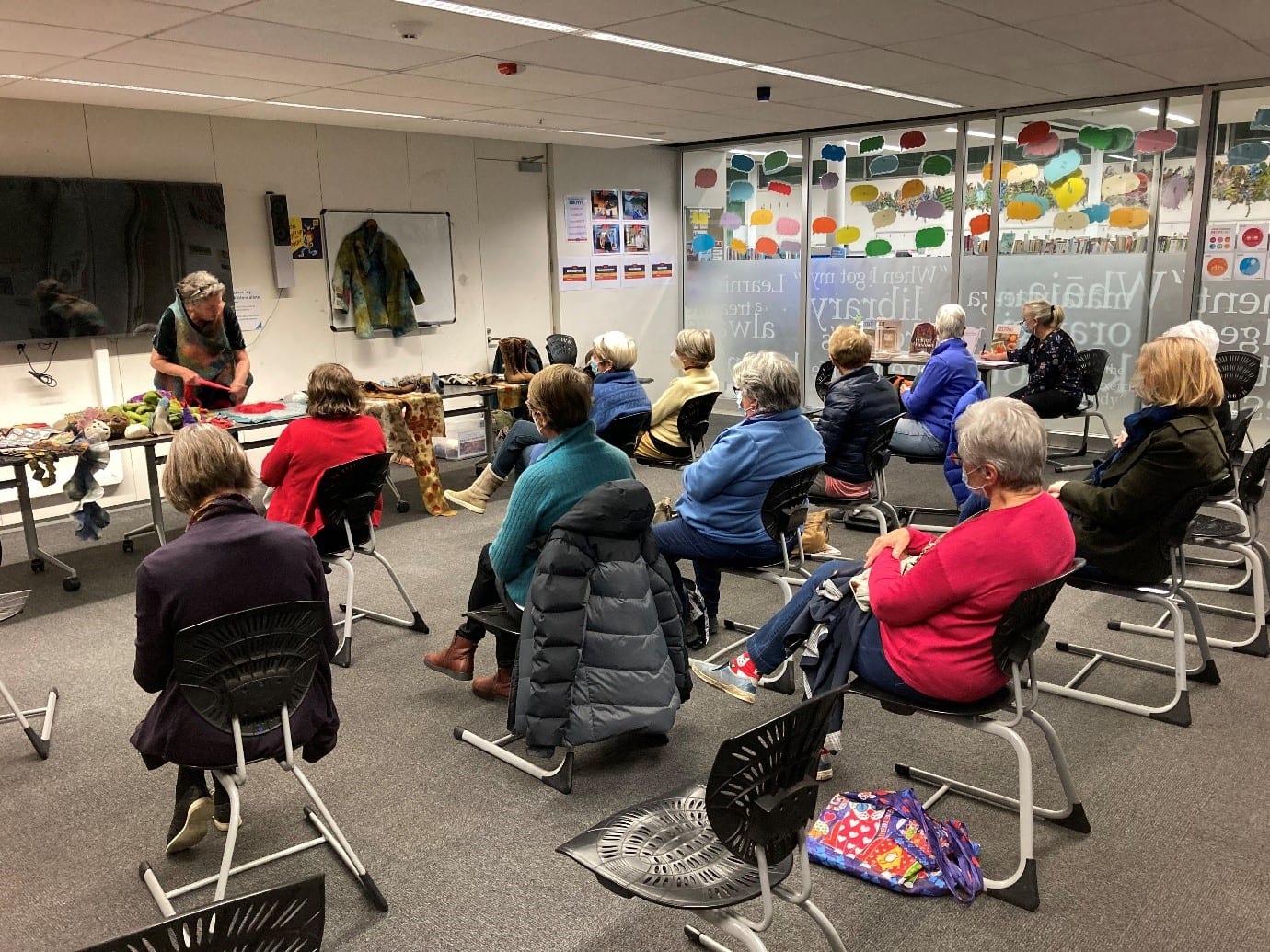Sally reports back from the last Craft Snippets event at Upper Riccarton library with featured felter, Jane Dolan. The next Craft snippets event will be at 6.30-7.30pm Wednesday 27 July and will feature sewing expert Rachael Okey.
It was lovely to get together again to hear felter, Jane Dolan talk about her craft.
Getting into felting and the felting community
Jane's intial exposer to fibre crafting was learnt from her Mother who was a keen spinner, knitter and natural dyer. Jane found felting about 13 years ago when she went along to a class with a friend. From there Jane joined the Southern Felters’ group. This is a busy group who meet once a month in Halswell and work on their own projects as well as organising classes for members. New people are welcome to pop along and have a look and/or join.
Jane is also a member of Creative Fibre NZ and the Canterbury Creative Fibre group who manage and supply a shop at the Tannery, Wool Yarn Fibre. It sounds like this shop at the Tannery is a must see if you have not been along there yet. There is a large workspace behind the shop that is used for range of groups and workshops for an amazing variety of fibre crafts.
As Jane’s felting skills have evolved, she has moved from using straight dyed commercial wool to experimenting with raw fleeces which she is really enjoying. One project in particular through the Christchurch Guild of Weavers and Spinners, has been to felt wool from different sheep breeds grown in New Zealand. Different fleeces have different uses. Merino is very soft and is lovely worn close to the skin. A mix of merino and silk is even softer and very light to wear for a handbag or boots (yes Jane brought along a pair of felted boots she had made at a workshop with Natalya Brashovetska).
Jane started off her felting by making scarves and has moved on to more 3D objects.
'No right and wrong with felting'
It depends on what you make as to how you set up the process. You lay the wool out in a criss cross fashion in layers. For a scarf it might just be two layers, for a bag maybe four or more layers. For a handle on a bag that needs to be extra strong it might need more layers. The great thing there is no right and wrong with felting and it is the fun of finding your own process and ways that Jane loves.
While Jane talked, she did a demonstration of how to felt. It was amazing watching her turn wool in to a beautiful poppy creation, all while we watched during the talk. To make the poppy, Jane first took a few random pieces of wool and laid it out. Jane then used water and a bit of soap to work the wool so that the scales of the wool rub together and stick together.
Felting has been around a long time and is very versatile. There is always more to learn, and this is one of the reasons Jane loves it so much. There is always something new to try.
At this point Jane added some silk fibre to the poppy she was demonstrating. Jane gets her silk fibre from the Southern Felters supplier Anna Harris who does not sell online but her fibre is available at the Wool Yarn Fibre Shop at the Tannery and at Southern Felters days and at Fibre Events around NZ. Jane also buys silk and fibre from Shona Schofield. Jane also buys silk scarves from op shops as she has a reduce, reuse, recycle ethos. The process of adding silk fabric in to felt is called Nuno Felting.
Jane said the first time she went to the Southern Felters Day event she couldn’t believe what people were making. There was a blanket like a compass that covered the floor, it was absolutely huge and Jane was enthralled.
A range of techniques and materials
At this stage of the demo Jane told us to not use too much water as "you don't want your fibre to be swimming". Jane said you can use a rattan blind or mesh to wrap the felt for the rolling process, but she prefers to simply reuse bubble wrap for the poppies. Jane then pressed the air out of it using her hands and a special felting stone made by The Crafted Owl. The agitating process makes the fibres hold on and stick to each other and also causes the project to shrink. Each felter will have their own way for how hot the water and what sort of soap and rubbing and rolling to do depending on what wool they are felting. Jane felt you can’t really go too wrong and if something doesn’t work out you call it a ’design feature’.
Jane showed some of her work that have crevices and holes and explained how she uses underlay to create these pieces. Jane does samples first to check on the shrinkage before going ahead with a piece. It doesn’t matter so much for scarves if the shrinkage is more than expected, but for garments you need to do a sample first to be sure. At the pre-felt/half felted stage stage you can add other pieces such as tails, legs, spikes, or pretty much anything you like.
Jane does a lot of experimentation using different types of wool and seeing what design elements can be created. Jane showed us examples of what she has been making with different wools.

Including some pieces that have English Leicester and Gotland sheep wool included. When this is felted it keeps its’ curl and becomes incredibly soft. A friend of Jane’s used this wool to make seat covers for their car. They felted the blunt side of the fleece (the cut end) and this sat on the seat, and they kept the curls on top, where the person sits. You can find some of the lovely Gotland locks at Tawhai Gotland NZ.
Where to learn, find information and materials
Jane has taken part in felting workshops from both international felting experts and local felters, in person and online courses and is part of the online felting community.
Jane shared a wealth of links including:
- Southern Felters
- Online felting group Felting and Fiber
- Felt and Fibre (Shona Schofield)
- Charity van de Meer
- Fiona Duthie
- Natalya Brashovesta
- Wendy Bailey
Jane showed the garments she has made and how versatile they are. Many can be worn in different ways. Some had what is called a ‘cracked mud effect’, this comes about when you use tape during the felting process.
Jane had suggestions where to buy wool for felting in NZ including, WoolYarnFibre, Greenacres Fibre Processing, Kane Carding, and Tally Ho Wool Carding.
Jane also showed us some eco printing she has done using leaves to add colour and design elements. The natural tannin comes out of the leaves and the designs on the fibre/silk are beautiful. Something Jane has only just recently having a go at. Thanks to textile artist Nicola Brown from Clasheen in Ireland, for so many wonderful felting and eco printing tips and tricks.
Jane really encouraged us to look up the local Canterbury Felting group the Southern Felters. They meet the first Saturday of every month in the Halswell Hall, for everyone to bring their own projects and come together and felt. Keep an eye out for their upcoming classes.
One Craft Snippets audience member has already reported back that she was so inspired she went straight out and bought some wool to start her felting journey.
New crafting titles
Angela did a round up of the latest crafting books and magazines in the Library. Do pop a hold on any you are keen to borrow.
New items shared at our March gathering.
Upcoming craft events
We did a round up of what is on in Christchurch including:
- If you are keen on knitting and crochet classes and would like to learn the basics, there are people who can teach for free at the Upper Riccarton Library knit 'n' yarn sessions on Tuesday afternoons and Thursday mornings.
- Great Stash Swap events at libraries, including at New Brighton Library 9 - 17 July.
- Next Craft Snippets with sewing expert Rachael Okey, 27 July
- The Encraftment Market on 2-3 July at Pioneer Stadium
- Amyes Road Market, Hornby Indoor Market – indoor/outdoor market held on the first and third Saturday of the month.
- Vintage Revamp at Wigram – Sunday 28 August at the Air Force Museum.
Find out more about felting
- Local felting groups on CINCH (Community Information Christchurch)
- Find felting books and eBooks in the library catalogue





Add a comment to: Craft Snippets: Felting with Jane Dolan